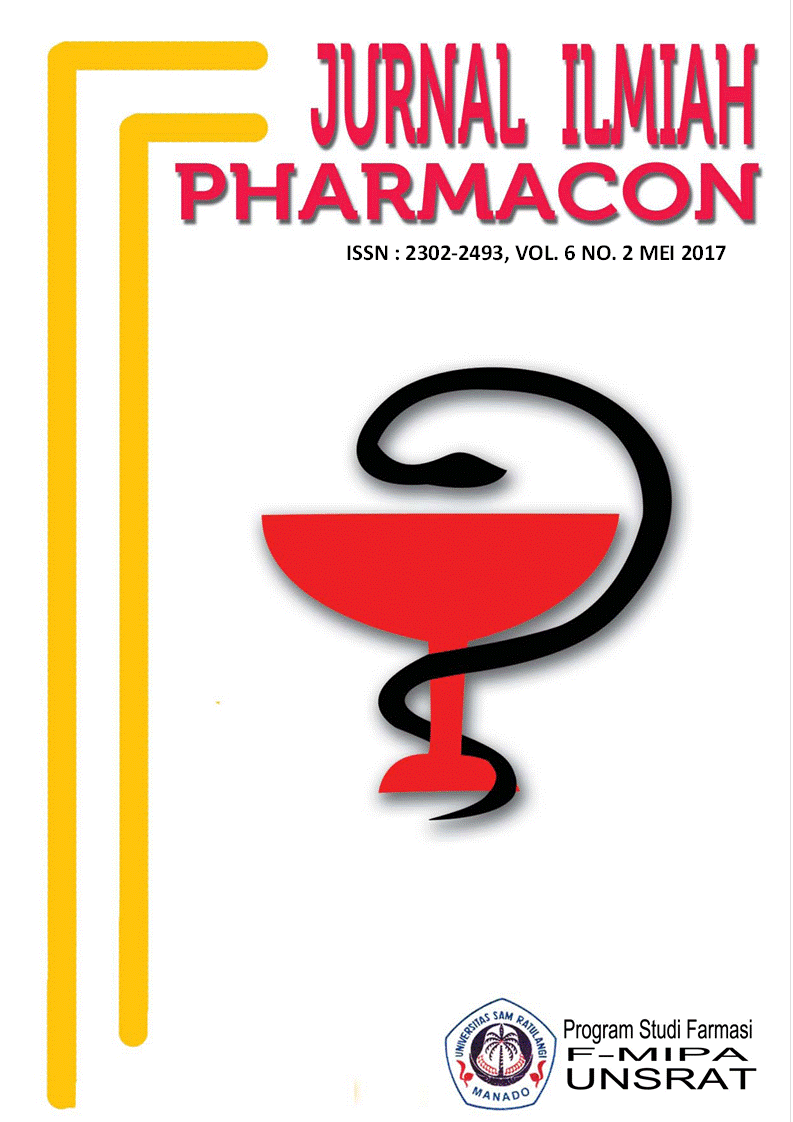UJI DAYA HAMBAT PERASAN RIMPANG KUNYIT (Curcuma longa L.) TERHADAP PERTUMBUHAN Candida albican
DOI:
https://doi.org/10.35799/pha.6.2017.15831Abstract
UJI DAYA HAMBAT PERASAN RIMPANG KUNYIT
 (Curcuma longa L.) TERHADAP PERTUMBUHAN
Candida albicans
Â
I Kadek Harianto1) , Pieter L. Suling1), Christy Mintjelungan1)
1) Program Studi Pendidikan Dokter Gigi Fakultas Kedokteran UNSRAT Manado, 95115
Â
Â
ABSTRACT
Â
         Candida albicans are the microorganism who present in oral cavity. Candida has more than 200 different species, 75% of fungus infections in oral cavity are caused by Candida albicans. Candida albicans can become opportunistic pathogen in certain condition such as bad oral hygine, bad immune system, and systemic disease. Turmeric (Curcuma longa L.) is one kind of plant belonging to the family of Zingiberaceae. Turmeric (Curcuma longa L.) have properties as herbal and traditional medicine for various diseases. Compounds in turmeric such as curcumin and essential oil has a role as an antioxidant, anticancer, antitumor, antifungal, and antivenom. The purpose of this study was to determine the inhibition of turmeric (Curcuma longa L.) to the growth of Candida albicans.This study is a true experimental in vitro with post test only control group design. Testing method using Kirby-bauer method by filterpaper. Turmeric sample were grated, squeezed then filtered and stored in a sterile sealed glass bottles. Candida albicans was taken from pure stock Pharmacy Laboratory Faculty of Math and Science, University of Sam Ratulangi.The results of this study obtained inhibition zone diameter turmeric (Curcuma longa L.) on the growth of Candida albicans in the amount of 11,1 mm which is strong inhibition category. As the conclution, turmeric
(Curcuma longa L.) has an inhibitory effect on Candida albicans fungus growth.
Â
Keywords:Turmeric(Curcuma longa L.), Candida albicans,Inhibibotory zone
Â
Â
ABSTRAK
Â
Candida albicans merupakan mikroorganisme yang terdapat di dalam rongga mulut. Candida memiliki sekitar 200 spesies yang berbeda, 75% infeksi jamur di rongga mulut pada manusia disebabkan oleh Candida albicans. Candida albicans dapat menjadi patogen oportunistik dalam keadaan tertentu seperti kebersihan rongga mulut yang buruk, penurunan sistem imun dan riwayat penyakit sistemik. Rimpang kunyit (Curcuma longa L.) merupakan salah satu jenis tanaman yang termasuk dalam keluarga Zingiberaceae. Rimpang kunyit (Curcuma longa L.) mempunyai khasiat sebagai jamu dan obat tradisional untuk berbagai jenis penyakit. Senyawa yang terkandung dalam rimpang kunyit (Curcuma longa L.) seperti curcumin dan minyak atsiri mempunyai peranan sebagai antioksidan, antitumor, antikanker, antijamur, antimikroba, dan antiracun.Tujuan penelitian ini yaitu untuk mengetahui daya hambat perasan rimpang kunyit (Curcuma longa L.) terhadap pertumbuhan jamur Candida albicans. Penelitian ini merupakan penelitian laboratorium eksperimental secara in vitro dengan rancangan penelitian Post test only control group design. Metode pengujian menggunakan metode Kirby-bauer berbahan kertas saring. Sampel rimpang kunyit (Curcuma longa L.) diparut, diperas dan disaring serta disimpan dalam botol kaca steril. Jamur Candida albicans diambil dari stok biakan jamur murni Laboratorium Farmasi FMIPA Universitas Sam Ratulangi Manado.Hasil penelitian ini didapat diameter zona hambat perasan rimpang kunyit (Curcuma longa L.) pada pertumbuhan Candida albicans yaitu sebesar 11,1 mm dan tergolong dalam kriteria zona hambat kuat. Kesimpulannya perasan rimpang kunyit (Curcuma longa L.) mempunyai daya hambat terhadap pertumbuhan jamur Candida albicans.
Â
Kata kunci: Rimpang kunyit (Curcuma longa L.), Candida albicans, Zona hambat
Downloads
Published
How to Cite
Issue
Section
License
Authors who publish with this journal agree to the following terms:
- Authors retain copyright and grant the journal right of first publication with the work simultaneously licensed under a Creative Commons Attribution-NonCommercial 4.0 International License that allows others to share the work with an acknowledgement of the work's authorship and initial publication in this journal.
- Authors are permitted and encouraged to post their work online (e.g., in institutional repositories or on their website) prior to and during the submission process, as it can lead to productive exchanges, as well as earlier and greater citation of published work (See The Effect of Open Access)










